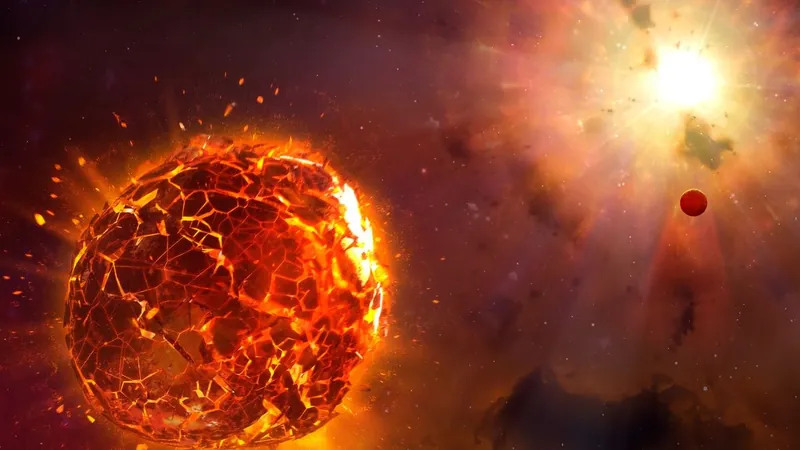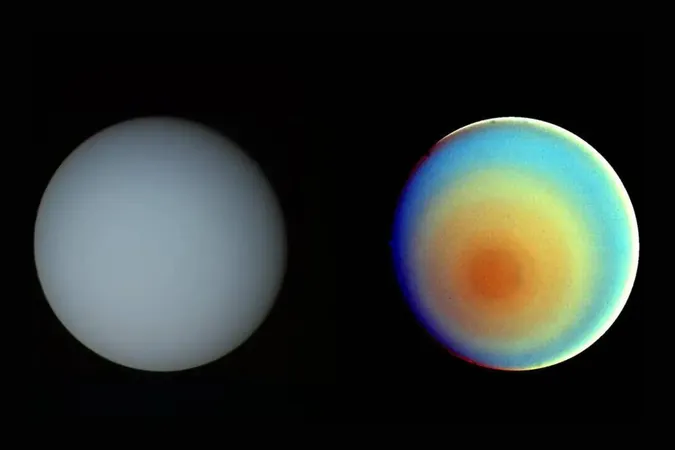
Could a Supernova Ever Spell Doom for Earth? Here’s What You Need to Know!
2024-11-14
Author: Wei
Introduction
Imagine standing outside on a clear night and witnessing the spectacular explosion of the star Betelgeuse. When it goes supernova, it will shine brighter than any planet and could even rival the brightness of the full moon! For several months, this celestial event will be visible even during the day. You could quite literally read a book under its luminescence at midnight! But hold your horses—while it may be a breathtaking sight, it won't pose any danger to us on Earth.
Distance Matters!
You see, Betelgeuse lies approximately 650 light-years away, well beyond the range of any harmful effects from its impending explosion. So, are there any stars that could threaten our planet?
Understanding Supernova Risks
To understand the risks, we need to grasp the destructive power of a supernova. A powerful shock wave accompanies the explosion, but if you were close enough to worry about that, you’d likely already be cooked from the intense radiation emitted by the pre-supernova star. Therefore, it’s safe to say that if you’re near enough to a supernova to feel the blast, survival was already improbable.
The Light Show vs. Reality
What about the dazzling visible light from the explosion? While it's a magnificent spectacle, it poses no threat to the Earth's safety. The real concern lies in the energy output predominantly composed of neutrinos, which are elusive particles that barely interact with matter. Trillions of neutrinos are passing through your body at this very moment—yes, seriously—without you feeling a thing! So even a barrage of neutrinos from a supernova wouldn’t bother you.
High-Energy Radiation
Now, let’s talk about more dangerous wavelengths like X-rays and gamma rays. Fortunately, supernovae don’t typically unleash massive amounts of high-energy radiation. Nonetheless, when viewed on an absolute scale, they still emit a significant quantity.
Cosmic Rays and Their Hazards
One of the serious threats from a supernova explosion is the production of cosmic rays, which are particles accelerated to nearly the speed of light. These cosmic rays can wreak havoc by tearing apart molecules in the Earth's atmosphere, particularly nitrogen and oxygen. This disruption can lead to the creation of nitrogen oxides, which is a major contributor to ozone layer depletion.
The Ozone Layer Concern
If Earth's protective ozone layer is compromised, ultraviolet (UV) radiation from the sun can penetrate more easily. This wouldn't just result in sunburns or higher skin cancer rates; the very foundation of our ecosystem could be at risk. Photosynthetic microorganisms, like algae, could be devastated—setting off a catastrophic chain reaction throughout the food web.
Current Supernova Threats
Research indicates that for a supernova to significantly affect Earth, the dying star would need to be within about 25 to 30 light-years away. Thankfully for us, there are currently no known supernova threats that lie within this range. The closest candidate, Spica, is a safe 250 light-years away, and no stars are likely to become supernovae in proximity during their lifetimes.
Long-term Risks
However, the narrative might change over long timelines. Our solar system is traversing through the Orion arm of the Milky Way, which is known for producing new stars at an accelerated rate. With increased star formation comes a higher likelihood of supernovae, potentially increasing the risk over the next 10 million years it will take to cross this arm.
Historical Context
Estimations suggest encounters with harmful supernovas might happen every few billion years. Some astronomers speculate that a nearby supernova may have contributed to a mass extinction event around 360 million years ago, wiping out 75% of all species!
Unique Danger of Dusty Supernovae
There's still more to consider: while typical supernovae pose a manageable risk, a unique situation arises when a dying star is covered in dust. As the supernova’s shock wave interacts with this dust, X-rays can be unleashed, weakening planetary atmospheres and leading to cosmic rays wreaking more havoc in the centuries that follow.
Type Ia Supernovae
Type Ia supernovas are another point of concern. Triggered by material accumulating on white dwarfs, these explosions can occur unpredictably, striking suddenly without warning. Fortunately, the nearest candidate, IK Pegasi, is 150 light-years away, putting it in a relatively safe zone.
Gamma-Ray Bursts
Perhaps the most terrifying aspect of stellar violence is the gamma-ray bursts produced by neutron star mergers, which could potentially devastate planetary atmospheres from vast distances of over 10,000 light-years. Their unpredictable nature makes it hard to safeguard against them, adding another layer of complexity to cosmic threats.
Conclusion
So, next time you gaze up at the stars, remember: while supernovae might be mesmerizing, their potential for destruction adds an exciting, albeit alarming, chapter to our cosmic story. Sleep tight, Earthlings—at least for now!




 Brasil (PT)
Brasil (PT)
 Canada (EN)
Canada (EN)
 Chile (ES)
Chile (ES)
 España (ES)
España (ES)
 France (FR)
France (FR)
 Hong Kong (EN)
Hong Kong (EN)
 Italia (IT)
Italia (IT)
 日本 (JA)
日本 (JA)
 Magyarország (HU)
Magyarország (HU)
 Norge (NO)
Norge (NO)
 Polska (PL)
Polska (PL)
 Schweiz (DE)
Schweiz (DE)
 Singapore (EN)
Singapore (EN)
 Sverige (SV)
Sverige (SV)
 Suomi (FI)
Suomi (FI)
 Türkiye (TR)
Türkiye (TR)